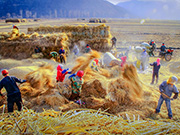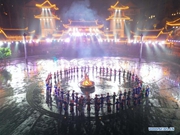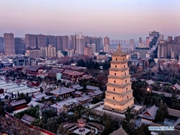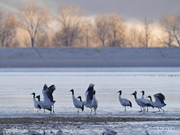

Japan 5.5
(Photo/People.cn)
In Japan, May 5 was originally called Tango no sekku (端午の節(jié)句), one of the five annual ceremonies held at the imperial court. Until 1948, Children's Day was known as Boys' Day, which celebrated boys and recognizing fathers, as the counterpart to Girls' Day on March 3. In 1948, the name was changed to Children's Day to include both male and female children, as well as recognizing mothers along with fathers and the family quality of unity.
On this day, families raise koinobori, which are carp-shaped windsocks, with a black carp for the father, a red or pink for the mother, and one carp (usually blue, and sometimes additionally green and orange) for each child. Traditionally, when celebrated as Boys' Day, the red koinobori was for the eldest son with blue and additional colors for younger brothers.
Apart from March 3 and May 5, Japan also celebrates Shichi-Go-San ("Seven-Five-Three"), a traditional celebration in Japan for three- and seven-year-old girls and five-year-old boys. The festival is held annually on November 15 to celebrate the growth and well-being of young children. On this day, children wear their best kimono and accompany their parents to the shrine to pray for health and safety.
 |  |

 Award-winning photos show poverty reduction achievements in NE China's Jilin province
Award-winning photos show poverty reduction achievements in NE China's Jilin province People dance to greet advent of New Year in Ameiqituo Town, Guizhou
People dance to greet advent of New Year in Ameiqituo Town, Guizhou Fire brigade in Shanghai holds group wedding
Fire brigade in Shanghai holds group wedding Tourists enjoy ice sculptures in Datan Town, north China
Tourists enjoy ice sculptures in Datan Town, north China Sunset scenery of Dayan Pagoda in Xi'an
Sunset scenery of Dayan Pagoda in Xi'an Tourists have fun at scenic spot in Nanlong Town, NW China
Tourists have fun at scenic spot in Nanlong Town, NW China Harbin attracts tourists by making best use of ice in winter
Harbin attracts tourists by making best use of ice in winter In pics: FIS Alpine Ski Women's World Cup Slalom
In pics: FIS Alpine Ski Women's World Cup Slalom Black-necked cranes rest at reservoir in Lhunzhub County, Lhasa
Black-necked cranes rest at reservoir in Lhunzhub County, Lhasa China's FAST telescope will be available to foreign scientists in April
China's FAST telescope will be available to foreign scientists in April